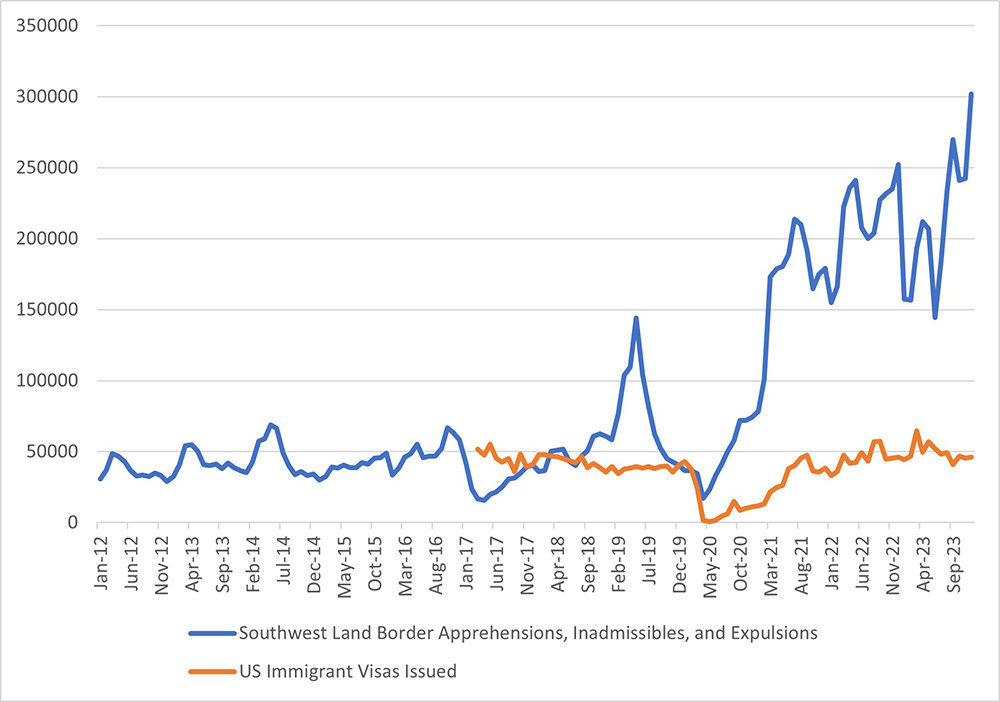Investigating the Immigrant Influx
One factor making the tight post-recession labor market feel a little less tight has been an increase in the supply of foreign-born immigrant workers. As shown in Figure 1 below, foreign-born workers made up close to 19 percent of the labor force in recent months, up from a pre-pandemic share of about 17.5 percent. While the foreign-born share of the labor force has been increasing since the Great Recession (despite a temporary lull from 2019 to 2021), today's foreign-born labor force share is higher than the level implied by the 2010-2019 pre-pandemic trend. Figure 1 also shows that foreign-born individuals make up 17.8 percent of the civilian, noninstitutional population as of January, which (like the labor force share) is up about 1.5 percentage points from pre-pandemic levels and above its pre-pandemic trend.
Estimates of the foreign-born population in the United States are developed as part of the Current Population Survey, a survey of about 60,000 households that is the main data source for the closely watched monthly unemployment and labor force statistics. Foreign-born individuals are defined as "persons who reside in the United States but who were not U.S. citizens at birth. ... The foreign-born include legally admitted immigrants, refugees, temporary residents such as students and temporary workers, and undocumented immigrants."
Figure 2 below shows that the increase in the foreign-born labor force share has been driven by both an increase in the number of foreign-born workers and a decline in the number of native-born workers, compared to 2010-2019 pre-pandemic trends. The level of foreign-born workers is 1.6 percent above its pre-pandemic trend, while the native-born labor force is about 1 percent smaller than its 2010-2019 pre-pandemic trend would imply.
One challenge in studying immigration is that data on undocumented, illegal immigration are scarce. For example, the Bureau of Labor Statistics does not distinguish undocumented immigrants from other immigrants in its estimates of foreign-born population. A recent Congressional Budget Office (CBO) report attributes elevated immigration in 2023 and 2024 as "primarily reflecting" growth in the "other-foreign-national" category, which includes those who entered the United States illegally and those who were permitted to enter via parole authority and may be awaiting proceedings in immigration court.
Other evidence suggests that undocumented immigration may be on the rise. Figure 3 below shows a contrast in recent trends of U.S. immigration visas (one channel for documented immigration) and Customs and Border Protection encounters and apprehensions along the southwestern border of the United States (a channel for undocumented immigration).1 This figure indicates that border apprehensions have risen 723 percent from February 2020 pre-pandemic levels, while visa issuance is up only 23 percent from pre-pandemic levels.
Will the outsized contribution of foreign-born workers to the U.S. labor supply continue? The outlook is highly uncertain. Figure 4 below reproduces a figure from the CBOs latest population forecast, comparing its forecast for net immigration to those of other government agencies. The CBOs baseline forecast calls for immigration to decline in 2025 and 2026 as the immigration system adjusts to addressing the current increase in migrant flows. A normalization of immigrant flows to historical levels could also be possible if today's elevated levels represent pent-up immigration after pandemic lockdowns and restrictions. Whatever the outcome, the foreign-born labor force will remain an important influence on the labor market landscape going forward.
According to a U.S. Customs and Border Protection report, border encounters may "overstate the number of unique individuals arriving at the border," as it would potentially include individuals making multiple border crossing attempts.
Views expressed in this article are those of the author and not necessarily those of the Federal Reserve Bank of Richmond or the Federal Reserve System.





